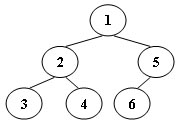1086 Tree Traversals Again (25分)
An inorder binary tree traversal can be implemented in a non-recursive way with a stack. For example, suppose that when a 6-node binary tree (with the keys numbered from 1 to 6) is traversed, the stack operations are: push(1); push(2); push(3); pop(); pop(); push(4); pop(); pop(); push(5); push(6); pop(); pop(). Then a unique binary tree (shown in Figure 1) can be generated from this sequence of operations. Your task is to give the postorder traversal sequence of this tree.

Figure 1
Input Specification:
Each input file contains one test case. For each case, the first line contains a positive integer N (≤) which is the total number of nodes in a tree (and hence the nodes are numbered from 1 to N). Then 2 lines follow, each describes a stack operation in the format: "Push X" where X is the index of the node being pushed onto the stack; or "Pop" meaning to pop one node from the stack.
Output Specification:
For each test case, print the postorder traversal sequence of the corresponding tree in one line. A solution is guaranteed to exist. All the numbers must be separated by exactly one space, and there must be no extra space at the end of the line.
Sample Input:
6
Push 1
Push 2
Push 3
Pop
Pop
Push 4
Pop
Pop
Push 5
Push 6
Pop
Pop
Sample Output:
3 4 2 6 5 1
这个题,我一开始只看到push是按照前序遍历顺序push的,也看到了pop是按照中序遍历顺序pop的,但是没有把二者结合在一起。
蠢到死了啊啊啊。
所以上面说的,就是已经知道前序遍历和中序遍历求后序遍历。
1 /* 2 Push的顺序为前序遍历,Pop的顺序为中序遍历,所以这道题就是 3 已知前序遍历和中序遍历求后序遍历。 4 */ 5 #include <iostream> 6 #include <string> 7 #include <vector> 8 #include <stack> 9 #include <algorithm> 10 using namespace std; 11 12 vector <int> pre, in, post; 13 14 typedef struct Tree { 15 int data; 16 Tree *l, *r; 17 } *ptree; 18 19 ptree build(int pl, int pr, int il, int ir) { 20 if(pl > pr || il > ir) return NULL; 21 int pos; 22 for(int i = il; i <= ir; i ++) { 23 if(in[i] == pre[pl]) { 24 pos = i; 25 break; 26 } 27 } 28 ptree root = new Tree; 29 root -> data = in[pos]; 30 root -> l = root -> r = NULL; 31 root -> l = build(pl + 1, pl + pos - il, il, pos - 1); 32 root -> r = build(pl + pos - il + 1, pr, pos + 1, ir); 33 return root; 34 } 35 36 void post_order(ptree root) { 37 if(!root) return; 38 post_order(root -> l); 39 post_order(root -> r); 40 post.push_back(root -> data); 41 } 42 43 int main() { 44 string op; 45 int n, num; 46 cin >> n; 47 stack <int> s; 48 pre.push_back(-1); 49 in.push_back(-1); 50 for(int i = 0; i < 2 * n; i ++) { 51 cin >> op; 52 if(op == "Push") { 53 cin >> num; 54 pre.push_back(num); 55 s.push(num); 56 } else { 57 in.push_back(s.top()); 58 s.pop(); 59 } 60 } 61 post_order(build(1, n, 1, n)); 62 for(int i = 0; i < post.size(); i ++) { 63 if(i) cout << " "; 64 cout << post[i]; 65 } 66 cout << endl; 67 return 0; 68 }